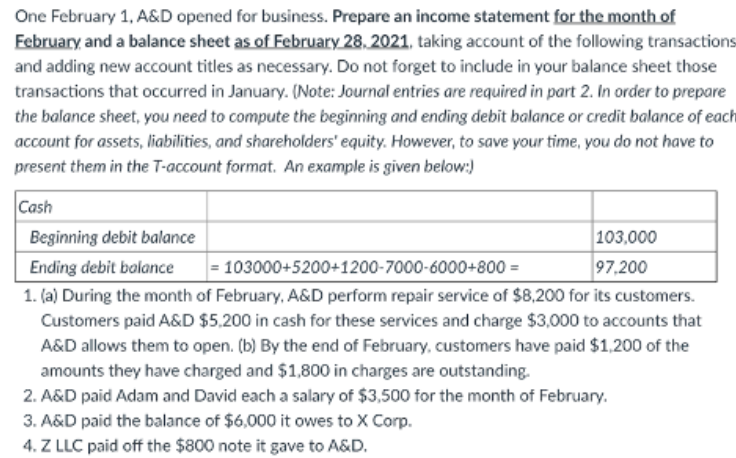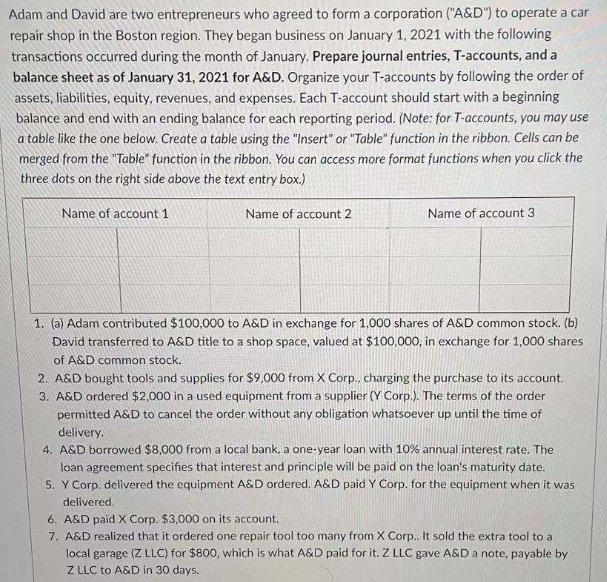Adam and David are two entrepreneurs who agreed to form a corporation ("A&D") to operate a car repair shop in the Boston region. They began business on January 1, 2021 with the following transactions occurred during the month of January. Prepare journal entries, T-accounts, and a
Adam and David are two entrepreneurs who agreed to form a corporation ("A&D") to operate a car repair shop in the Boston region. They began business on January 1, 2021 with the following transactions occurred during the month of January. Prepare journal entries, T-accounts, and a
College Accounting (Book Only): A Career Approach
13th Edition
ISBN:9781337280570
Author:Scott, Cathy J.
Publisher:Scott, Cathy J.
Chapter3: The General Journal And The General Ledger
Section: Chapter Questions
Problem 5PA: Following is the chart of accounts of Sanchez Realty Company: Sanchez completed the following...
Related questions
Topic Video
Question
100%

Transcribed Image Text:One February 1, A&D opened for business. Prepare an income statement for the month of
February and a balance sheet as of February 28, 2021, taking account of the following transactions
and adding new account titles as necessary. Do not forget to include in your balance sheet those
transactions that occurred in January. (Note: Journal entries are required in part 2. In order to prepare
the balance sheet, you need to compute the beginning and ending debit balance or credit balance of each
account for assets, liabilities, and shareholders' equity. However, to save your time, you do not have to
present them in the T-account format. An example is given below:)
Cash
103,000
97,200
Beginning debit balance
Ending debit balance
= 103000+5200+1200-7000-6000+800 =
1. (a) During the month of February, A&D perform repair service of $8,200 for its customers.
Customers paid A&D $5.200 in cash for these services and charge $3,000 to accounts that
A&D allows them to open. (b) By the end of February, customers have paid $1,200 of the
amounts they have charged and $1,800 in charges are outstanding.
2. A&D paid Adam and David each a salary of $3,500 for the month of February.
3. A&D paid the balance of $6,000 it owes to X Corp.
4. Z LLC paid off the $800 note it gave to A&D.

Transcribed Image Text:Adam and David are two entrepreneurs who agreed to form a corporation ("A&D") to operate a car
repair shop in the Boston region. They began business on January 1, 2021 with the following
transactions occurred during the month of January. Prepare journal entries, T-accounts, and a
balance sheet as of January 31, 2021 for A&D. Organize your T-accounts by following the order of
assets, liabilities, equity, revenues, and expenses. Each T-account should start with a beginning
balance and end with an ending balance for each reporting period. (Note: for T-accounts, you may use
a table like the one below. Create a table using the "Insert" or "Table" function in the ribbon. Cells can be
merged from the "Table" function in the ribbon. You can access more format functions when you click the
three dots on the right side above the text entry box.)
Name of account 1
Name of account 2
Name of account 3
1. (a) Adam contributed $100,000 to A&D in exchange for 1,000 shares of A&D common stock. (b)
David transferred to A&D title to a shop space, valued at $100,000, in exchange for 1,000 shares
of A&D common stock.
2. A&D bought tools and supplies for $9,000 from X Corp., charging the purchase to its account.
3. A&D ordered $2,000 in a used equipment from a supplier (Y Corp.). The terms of the order
permitted A&D to cancel the order without any obligation whatsoever up until the time of
delivery.
4. A&D borrowed $8,000 from a local bank, a one-year loan with 10% annual interest rate. The
loan agreement specifies that interest and principle will be paid on the loan's maturity date.
S. Y Corp. delivered the equipment A&D ordered. A&D paid Y Corp. for the equipment when it was
delivered.
6. A&D paid X Corp. $3,000 on its account.
7. A&D realized that it ordered one repair tool too many from X Corp.. It sold the extra tool to a
local garage (Z LLC) for $800, which is what A&D paid for it. Z LLC gave A&D a note, payable by
Z LLC to A&D in 30 days.
Expert Solution
This question has been solved!
Explore an expertly crafted, step-by-step solution for a thorough understanding of key concepts.
Step by step
Solved in 3 steps

Knowledge Booster
Learn more about
Need a deep-dive on the concept behind this application? Look no further. Learn more about this topic, accounting and related others by exploring similar questions and additional content below.Recommended textbooks for you

College Accounting (Book Only): A Career Approach
Accounting
ISBN:
9781337280570
Author:
Scott, Cathy J.
Publisher:
South-Western College Pub

Principles of Accounting Volume 1
Accounting
ISBN:
9781947172685
Author:
OpenStax
Publisher:
OpenStax College

Century 21 Accounting Multicolumn Journal
Accounting
ISBN:
9781337679503
Author:
Gilbertson
Publisher:
Cengage

College Accounting (Book Only): A Career Approach
Accounting
ISBN:
9781337280570
Author:
Scott, Cathy J.
Publisher:
South-Western College Pub

Principles of Accounting Volume 1
Accounting
ISBN:
9781947172685
Author:
OpenStax
Publisher:
OpenStax College

Century 21 Accounting Multicolumn Journal
Accounting
ISBN:
9781337679503
Author:
Gilbertson
Publisher:
Cengage

Financial Accounting
Accounting
ISBN:
9781305088436
Author:
Carl Warren, Jim Reeve, Jonathan Duchac
Publisher:
Cengage Learning

Financial Accounting
Accounting
ISBN:
9781337272124
Author:
Carl Warren, James M. Reeve, Jonathan Duchac
Publisher:
Cengage Learning

College Accounting (Book Only): A Career Approach
Accounting
ISBN:
9781305084087
Author:
Cathy J. Scott
Publisher:
Cengage Learning